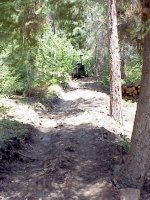radair
Gold Member
I've built many miles of trails for mountain bicycling, very similar to hiking & running trails. Many trail runners prefer our trails to typical eastern hiking trails because they are usually laid out at lower grades. In relatively flat terrain, you can get by with trimming branches with loppers or a brush axe. Depending on how much traffic you expect, raking is a popular way to establish the trail tread. In steeper terrain, bench cutting is necessary to avoid creating off-camber trails.
Be sure not to build fall-line trails - trails should traverse across slopes and not go directly up or down them. The general rule is that water is the vehicle that erodes soil, so you have to keep it flowing off the trail. Grade reversals are an effective way to prevent water from flowing down a trail.
There's loads of information available at the International Mountain Bicycling Association's trail building page: http://www.imba.com/resources/trail_building/index.html .
IMBA's new book on how to build singletrack trails is perhaps the most comprehensive trail building manual available. I highly recommend it, see http://www.imba.com/resources/trail_building/trail_solutions.html
Rob
Be sure not to build fall-line trails - trails should traverse across slopes and not go directly up or down them. The general rule is that water is the vehicle that erodes soil, so you have to keep it flowing off the trail. Grade reversals are an effective way to prevent water from flowing down a trail.
There's loads of information available at the International Mountain Bicycling Association's trail building page: http://www.imba.com/resources/trail_building/index.html .
IMBA's new book on how to build singletrack trails is perhaps the most comprehensive trail building manual available. I highly recommend it, see http://www.imba.com/resources/trail_building/trail_solutions.html
Rob

